15 High Street
15 High Street
The oldest building in the Borough, an ironmongery for over 200 years
Today's 15 High Street (it is technically High Street, although most people think of it as the Borough) was built around 1790 and is the oldest building in the Borough today. It is thought to have been built for ironmonger William Edwards and in the drawing of 1810 (see Gallery), Edwards' name is clearly visible on the front of the building. Unusually for this time, the ground floor was built with a series of four arch-topped shop display windows, the fifth (eastern) arch was the entrance to Narrow Lane (today's Tabernacle Lane).
William Edwards had been in business in the Borough at least as early as 1771, when he was listed as an ironmonger and cutler in the Universal British Directory. His last listing was in Pigot's Directory of 1824 in which he was listed as an ironmonger and manufacturer.
In 1827 Josiah Hannam (1796-1874), also an ironmonger, issued a circular announcing that he had moved his business to the Borough and taken over the ironmongery business "so long held by Mr Edwards". By 1843 Hannam had entered partnership with Alfred Gillett and the business was known as Hannam & Gillett from that time. Hannam was noted as the occupier of the Borough premises in 1847 when they were put up for sale by the owner for the sum of £1,200, but there were no bids.
In the 1851 census Josiah Hannam gave his occupation as "Ironmonger, firm of 2, employing 13 men". Living with him was his partner in the business Alfred Gillett, three assistants, a housekeeper and a house servant. By 1861, still living above his ironmongery shop in the Borough, he gave his occupation in the census as "Ironmonger employing 17 men and 8 Boys". Living with him above the shop were his partner 47-year old ironmonger Alfred Gillett, 22-year old assistant Thomas Denner, another assistant, an ironmonger's apprentice, a housekeeper and a general servant.
Hannam & Gillett's business was bought in 1865 by John Petter (1821-1898) of Barnstaple, Devon, who gave it to his son James Bazeley Petter (1847-1906) as a wedding present although the business was advertised as "John Petter, Ironmonger" until at least 1878. In the 1891 census James and Charlotte Petter were living above the ironmongery shop and had nine of their children living with them (altogether James and Charlotte were to have fifteen children). James listed his occupation as Ironmonger (Master) and the four eldest boys were all ironmongers' apprentices - James JB aged 19, twins Ernest and Percival (known as Percy) aged 17 and Hugh aged 16. Also living in was another apprentice as well as a cook, housemaid and nurse.
During the 1890s two young lads, Harry Hill (1865-1947) and John Sawtell (1881-1965), both worked for James Petter as assistants in the ironmongery side of Petter's business.
In 1901, as a financial crisis loomed in the many Petter business concerns, the twin sons of James Petter, Ernest and Percy, bought the various businesses from their father following which they reorganised and renamed it as James B Petter & Sons (Ltd) with both the sons as joint managing directors. Also a director for over thirty years was John Vincent. Their father James retired from business and died in Yeovil in 1906.
While Percy and Ernest Petter reorganised the company their brothers Harry and Hugh, trading under the name of 'HB & H Petter', managed the original business including the Foundry & Engineering Works in Clarence Street and, particularly, the ironmongery and hot water heating side of the company in the Borough. But, as Percy recalled later "It was however for some reason not very prosperous, and Hugh left to commence business and carry on missionary work in Buenos Aires, and later Harry left with his family to take up farming in Australia."
By 1911 that business was then formed into a company under the name of Hill, Sawtell & Co, in which the Petter family held the principal interest. Harry Hill and John Sawtell, as mentioned above, had both been associated with the business for some years and Percy Petter remained a director of the company until his death in 1955. Harry Hill died in 1947 and John Sawtell died in 1965. Harry's son James "Jimmy" Hill and John's son Havard Sawtell took over the business, which later 'down-sized' and traded from a smaller shop in Princes Street some time after 1965.
In the late 1970s or early 1980s 15 High Street was occupied by the SMS Drug Store (see Gallery) and since the 1990s has been the premises of Superdrug.
gallery
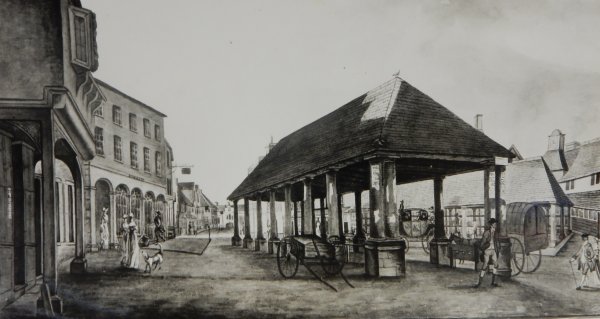
A painting made in 1810 of the Borough looking towards High Street which runs to the distance at left. The building at centre was the Market House, built in 1740, and behind it to the right was the Butchers' Shambles, built in 1803. At extreme left is the medieval building known as The Bow and to its right, the building with the arched ground floor is today's 15 High Street.
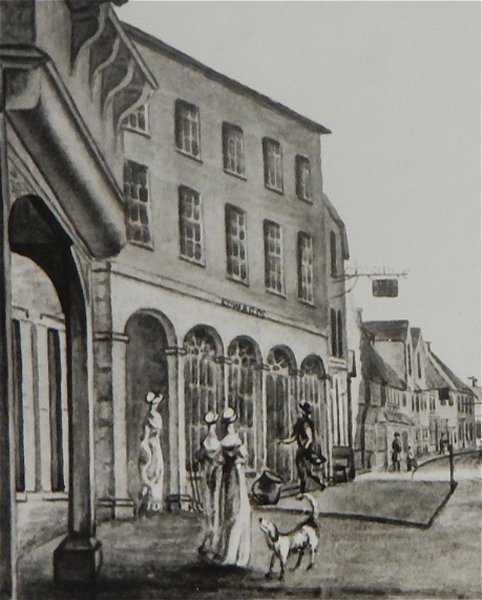
An enlargement of part of the previous painting of 1810 (when Yeovil appears to have been populated by very tall people), showing William Edwards' premises. The first arch, with the lady standing by it, is the entrance to Narrow Lane (today's Tabernacle Lane). It appears that it this time the building had a lawn in front of it - this was not unique, as the Medical Hall (to which this artist had his back while sketching) also had a small front lawn.
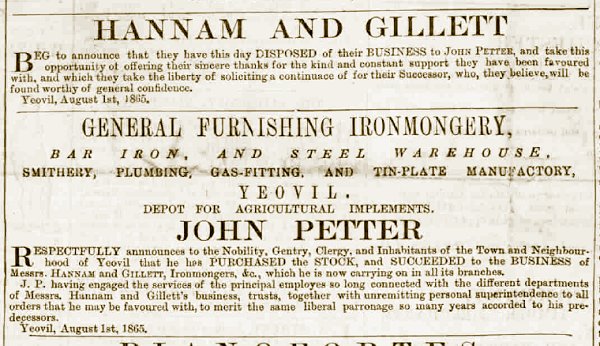
Courtesy of Mike
Taylor
Notice placed in the Western Flying Post's edition of 3 October 1865 announcing the sale of their business to John Petter, above Petter's notice of purchase.
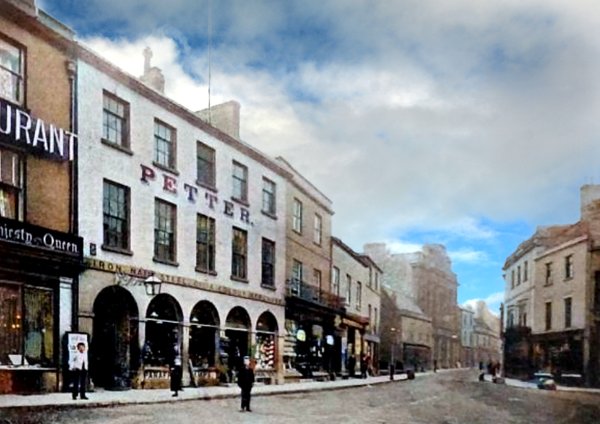
This colourised photograph
features in my
book 'Yeovil From Old Photographs'.
This photograph was taken by Yeovil Photographer Jarratt Beckett and published in his 1897 book "Somerset viewed through a Camera". At left is James Bazeley Petter's ironmongery store - he later opened another branch, just a few doors along in High Street, located next to the Town Hall.
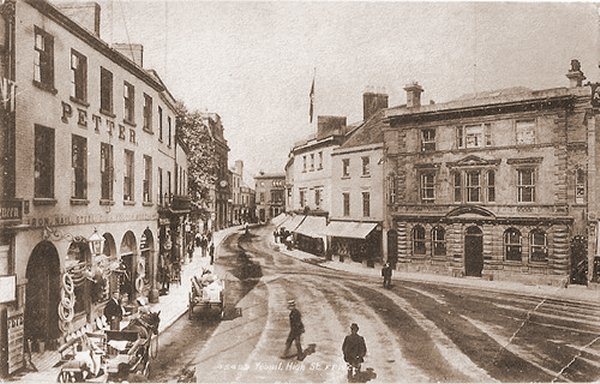
From my
collection
This postcard, dated 1905, looks from the first floor of the Medical Hall along High Street to Stuckey's Bank in Hendford.
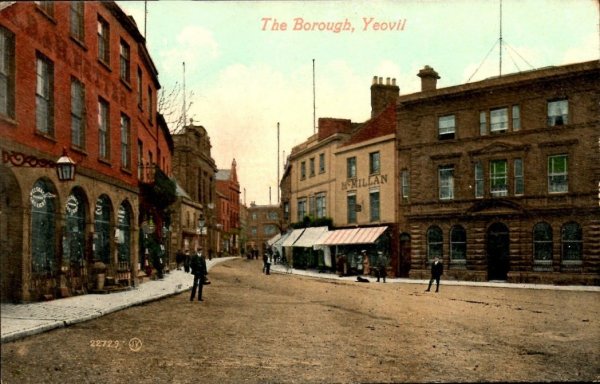
From my
collection
A heavily hand-tinted postcard of the Borough and High Street dating to about 1907. While Percy and Ernest reorganised the company their brothers Harry and Hugh, trading under the name of 'HB & H Petter', managed the original business in the Borough.
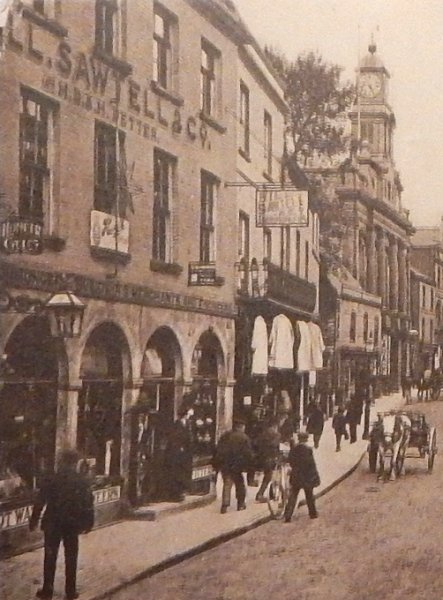
From my
collection
An enlargement from a postcard sent in 1926 by which time the company was Hill, Sawtell & Co late HB & H Petter.
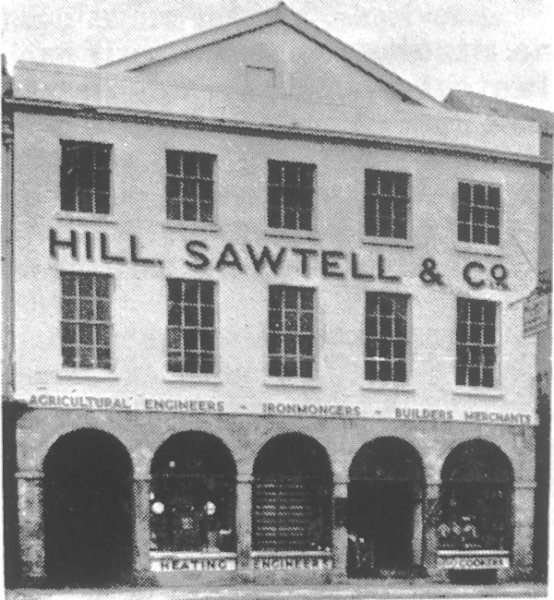
This photograph of Harry Hill and John Sawtell's ironmongery business in the Borough, formerly the shop of James B Petter, was taken most likely in the 1940s.
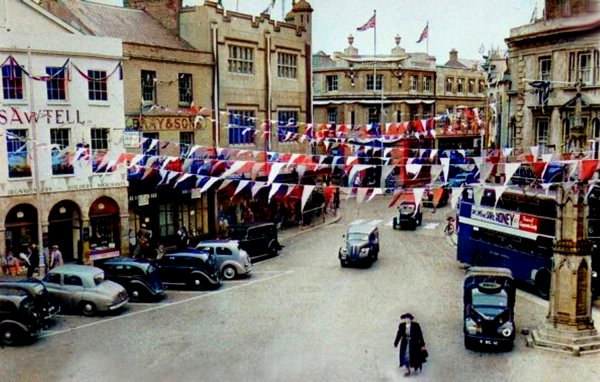
A colourised photograph of the Borough decorated in 1953 for Queen Elizabeth II's coronation. At far left 15 High Street was still at this time trading as Hill & Sawtell.
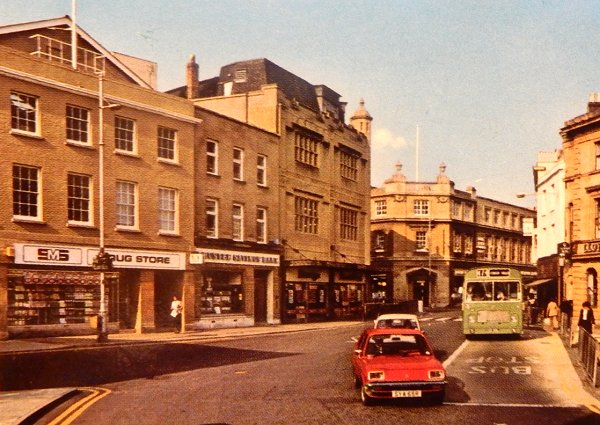
From my
collection
The Borough photographed in the late 1970s or early 1980s at which time 15 High Street was occupied by the SMS Drug Store. Note that the arched windows have finally gone and new shop-fronts installed.
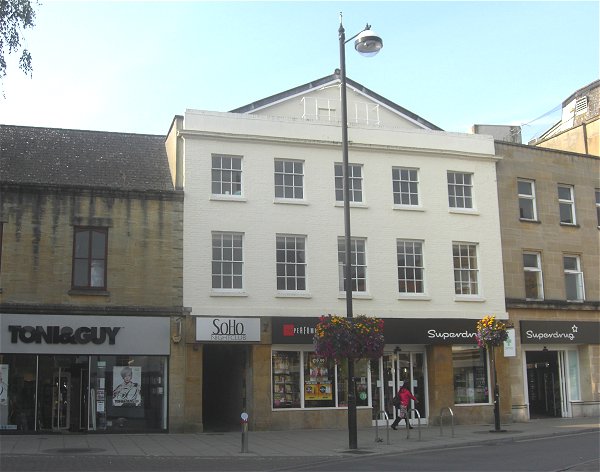
The oldest surviving building in the Borough and originally the ironmongery shop of William Edwards (in 1790), then Josiah Hannam followed by James Bazeley Petter and then Hill & Sawtell. Today it is Superdrug. Photographed in 2009.